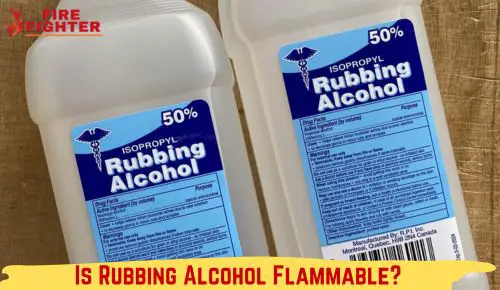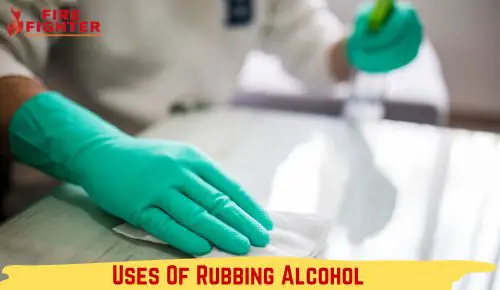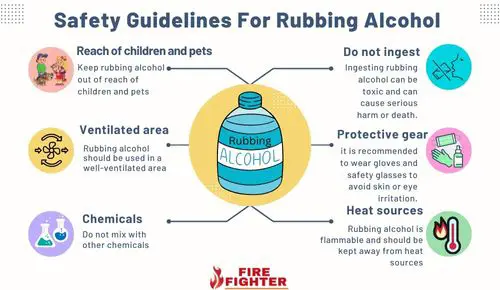Is Rubbing Alcohol Flammable?
Rubbing alcohol is a common household item that can be used for a variety of purposes.
From cleaning to sterilizing, it’s a versatile product that many people keep on hand.
However, one question that often comes up is whether or not rubbing alcohol is flammable.
While some may assume that the answer is a simple yes or no, there are actually a few factors that can affect its flammability.
In this blog post, we’ll explore the topic in more detail and provide you with the information you need to know.
Contents
- 1 What Is Rubbing Alcohol?
- 2 Is Rubbing Alcohol Flammable?
- 3 Is Rubbing Alcohol Flammable After It Dries?
- 4 At What Temperature Does Rubbing Alcohol Catch Fire?
- 5 What Happens When You Ignite Rubbing Alcohol
- 6 What Percent Rubbing Alcohol Flammable?
- 7 Is Rubbing Alcohol Toxic
- 8 Uses Of Rubbing Alcohol
- 9 What Percentage Of Rubbing Alcohol Is Safe?
- 10 Is Rubbing Alcohol Hazardous
- 11 What Are The 3 Types Of Rubbing Alcohol?
- 12 Is Rubbing Alcohol And Isopropyl Alcohol The Same
- 13 Rubbing Alcohol VS Acetone
- 14 Safety Guidelines For Rubbing Alcohol
- 15 Conclusion
What Is Rubbing Alcohol?
Rubbing alcohol is commonly used as a topical antiseptic to clean and disinfect wounds, and it is also used to clean surfaces and equipment in healthcare settings.
It is also used as a solvent in many household and industrial products, such as cosmetics, hand sanitizers, and perfumes.
Rubbing alcohol is available in varying strengths, typically ranging from 70% to 99% isopropyl alcohol.
The higher the percentage of isopropyl alcohol, the more effective it is as a disinfectant and solvent.
However, it is important to note that higher concentrations of rubbing alcohol can be more flammable and should be handled with care.
Rubbing alcohol should not be consumed or ingested, as it can cause serious health problems or even death. It should also be kept away from open flames or sparks, as it is highly flammable.
Is Rubbing Alcohol Flammable?
If this vapor comes into contact with a spark or open flame, it can ignite and cause a fire.
Therefore, it is important to handle rubbing alcohol with care, and keep it away from heat, open flames, and sparks. This is particularly important when using rubbing alcohol in large quantities or in areas with a fire or explosion risk, such as near electrical equipment or in poorly ventilated spaces.

It is important to note that the flammability of rubbing alcohol depends on its concentration. The higher the concentration of alcohol, the more flammable it is.
For example, rubbing alcohol that contains 90% isopropyl alcohol is much more flammable than a product that contains only 70% isopropyl alcohol.
Is Rubbing Alcohol Flammable After It Dries?
The short answer is yes, rubbing alcohol is flammable after it dries. Although rubbing alcohol evaporates quickly and leaves no residue, it is still a flammable substance.
The flammability of rubbing alcohol increases as its concentration increases.
This means higher concentration rubbing alcohol is more flammable than lower concentration rubbing alcohol.
Rubbing alcohol is made up of 70% to 99% isopropyl alcohol, which is a highly flammable chemical. The remaining percentage is water, which does not contribute to the flammability of the solution.
When rubbing alcohol is exposed to air, it evaporates quickly, leaving behind a dry surface.
However, even after it has completely evaporated, there may still be a residue of flammable liquid on the surface.
At What Temperature Does Rubbing Alcohol Catch Fire?
Rubbing alcohol, or isopropyl alcohol (IPA), is highly flammable and can catch fire at relatively low temperatures.
The flash point of rubbing alcohol is around 53°F (12°C), which means it can ignite easily at or above this temperature.
The ignition temperature of rubbing alcohol depends on its concentration. For example, 70% isopropyl alcohol has an ignition temperature of around 793°F (401°C), while 91% isopropyl alcohol has an ignition temperature of about 801°F (427°C).
It’s important to note that rubbing alcohol can ignite even below its ignition temperature if exposed to an ignition source, such as an open flame or spark.
Therefore, it’s essential to handle rubbing alcohol with care and keep it away from any potential ignition sources.
What Happens When You Ignite Rubbing Alcohol
When rubbing alcohol is ignited, it burns with a clean blue flame that is nearly invisible in daylight.
The flame produces carbon dioxide and water vapor as byproducts, making it a relatively clean-burning fuel.
However, burning rubbing alcohol can also release harmful fumes, such as carbon monoxide, which can be dangerous if inhaled in large quantities.
Additionally, the high heat produced by burning rubbing alcohol can be a fire hazard and can cause burns or other injuries if not handled properly.
It’s important to note that igniting rubbing alcohol should never be done intentionally, as it can be extremely dangerous and can easily result in injury or property damage.
If rubbing alcohol is accidentally ignited, it’s important to immediately extinguish the flame using a fire extinguisher or by smothering the flames with a non-flammable material like a blanket or sand.
If the fire is out of control, evacuate the area immediately and call the fire department.
What Percent Rubbing Alcohol Flammable?
All concentrations of rubbing alcohol, also known as isopropyl alcohol (IPA), are flammable to some extent. However, the degree of flammability varies depending on the concentration of IPA.
Rubbing alcohol solutions with higher concentrations of isopropyl alcohol are more flammable than those with lower concentrations.
For example, a 70% rubbing alcohol solution is less flammable than a 99% rubbing alcohol solution.
In general, rubbing alcohol solutions with a concentration of 50% or higher are highly flammable and should be handled with care.
It is important to keep rubbing alcohol away from heat sources, sparks, and open flames and to ensure proper ventilation when using rubbing alcohol or products containing it.
Is Rubbing Alcohol Toxic
The answer is yes and no. In small amounts, rubbing alcohol is not toxic and is safe for use. However, ingesting rubbing alcohol can be extremely dangerous and even deadly.
Ingesting just a small amount of rubbing alcohol can cause symptoms such as dizziness, nausea, and headache. Larger amounts can lead to more serious symptoms such as seizures and coma.
Inhaling rubbing alcohol can also be dangerous. Breathing in rubbing alcohol fumes can irritate the nose, throat, and lungs.
This can lead to symptoms such as coughing, wheezing, and shortness of breath.
Prolonged exposure to rubbing alcohol fumes can also cause headaches, dizziness, and nausea.
When using rubbing alcohol, taking precautions is important to avoid ingestion and inhalation.
Always use rubbing alcohol in a well-ventilated area and wear protective gloves and eyewear.
Keep rubbing alcohol out of reach of children and pets, and never ingest rubbing alcohol or use it to clean deep or bleeding wounds.
Uses Of Rubbing Alcohol

Rubbing alcohol, also known as isopropyl alcohol (IPA), has a variety of uses due to its antiseptic, disinfectant, and solvent properties. Here are some common uses of rubbing alcohol:
Disinfectant: Rubbing alcohol is commonly used to clean and sanitize surfaces and equipment. It can kill bacteria, viruses, and fungi.
First aid: Rubbing alcohol can be used as a first-aid antiseptic to clean wounds, cuts, and scrapes. It can also be used to clean and disinfect medical equipment.
Hand sanitizer: Rubbing alcohol can be used to make hand sanitizer on its own or in combination with other ingredients such as aloevera gel or essential oils.
Electronics cleaning: Rubbing alcohol is often used to clean electronics, such as keyboards, screens, and other equipment. It can be used to remove dirt, grime, and smudges.
Stain removal: Rubbing alcohol can remove stains from clothing and other fabrics, such as ink or marker stains.
Deodorant: Rubbing alcohol can be used as a natural deodorant due to its ability to kill bacteria that cause odor.
Solvent: Rubbing alcohol is often used to dissolve and remove substances such as oils, greases, and waxes.
It’s important to note that rubbing alcohol should be used cautiously and per the instructions on the label.
It should not be ingested or used in large quantities, and care should be taken to avoid contact with eyes and mucous membranes.
What Percentage Of Rubbing Alcohol Is Safe?
Rubbing alcohol, or isopropyl alcohol (IPA), can be safe when used properly in appropriate concentrations.
However, the safe concentration of rubbing alcohol depends on its intended use.
For general disinfecting purposes, a 70% solution of rubbing alcohol is considered to be safe and effective.
This concentration is commonly used in hospitals, clinics, and other healthcare settings for surface disinfection.
However, for certain applications, such as cleaning electronics or removing stains, higher concentrations of rubbing alcohol may be necessary.
In these cases, following the manufacturer’s instructions and using the product in a well-ventilated area is important.
It’s also important to note that rubbing alcohol should never be ingested or used on the skin in its undiluted form.
Undiluted rubbing alcohol can cause skin irritation and drying, and can be harmful if ingested.
Is Rubbing Alcohol Hazardous
Rubbing alcohol, or isopropyl alcohol (IPA), can be hazardous if not used properly. Here are some potential hazards associated with rubbing alcohol:
Flammability: Rubbing alcohol is highly flammable and can easily ignite if exposed to heat sources, sparks, or flames. Care should be taken to keep rubbing alcohol away from open flames and to use it in well-ventilated areas.
Inhalation: Inhaling rubbing alcohol fumes can be harmful and cause irritation to the eyes, nose, and throat.
Prolonged exposure to high concentrations of rubbing alcohol fumes can cause dizziness, headaches, and nausea.
Skin and eye irritation: Undiluted rubbing alcohol can cause skin irritation, dryness, and cracking. It can also cause eye irritation if it comes into contact with the eyes.
Toxicity: Ingesting rubbing alcohol can be toxic and cause various symptoms, including nausea, vomiting, dizziness, and confusion. In severe cases, it can cause seizures and coma.
Environmental hazards: Rubbing alcohol should be disposed of properly, as it can be harmful to the environment.
It should not be poured down the drain or disposed of in the trash.
What Are The 3 Types Of Rubbing Alcohol?
There are typically three types of rubbing alcohol available on the market:
Isopropyl Alcohol: This rubbing alcohol is the most commonly used and is made from propene, a byproduct of oil refining.
It is often sold in concentrations ranging from 70% to 99%, with 70% being the most commonly available concentration.
Ethanol Alcohol: This rubbing alcohol is made from fermented corn or other grain products. It is often sold in concentrations ranging from 70% to 95%. Ethanol alcohol is often used in medical settings as a disinfectant and antiseptic.
Denatured Alcohol: This rubbing alcohol is made by adding small amounts of chemicals to either isopropyl alcohol or ethanol to make it unfit for human consumption.
Denatured alcohol is often used in industrial settings as a solvent or fuel.
It is important to note that while all three types of rubbing alcohol can be effective as disinfectants and cleaning agents, they each have different properties and should be used for their intended purposes.
It is also important to use rubbing alcohol in a well-ventilated area and to avoid inhaling or ingesting it, as it can be harmful if not used properly.
Is Rubbing Alcohol And Isopropyl Alcohol The Same
No, rubbing alcohol and isopropyl alcohol are not the same thing.
Rubbing alcohol is a solution that typically contains 70% isopropyl alcohol and 30% water.
This solution is often used as a disinfectant or cleaning agent because of its antimicrobial properties.
The water content in the solution helps to slow the evaporation rate of the isopropyl alcohol, which makes it more effective at killing germs.
Isopropyl alcohol, on the other hand, is a pure chemical compound that is typically sold in concentrations ranging from 70% to 99%.
It is commonly used as a solvent, cleaning agent, or fuel in industrial applications. It can also be used as a disinfectant or antiseptic, but it is generally considered to be less effective than a 70% solution of isopropyl alcohol in water.
One important difference between rubbing alcohol and isopropyl alcohol is the concentration.
Rubbing alcohol is specifically formulated to contain 70% isopropyl alcohol and 30% water, whereas isopropyl alcohol can be found in various concentrations.
Higher concentrations of isopropyl alcohol can be more effective at killing germs, but they can also be more dangerous to handle due to their flammability.
Rubbing Alcohol VS Acetone
Rubbing alcohol and acetone are both solvents that are commonly used in a variety of household and industrial applications.
While the two have some similarities, there are also some important differences.
Rubbing alcohol, also known as isopropyl alcohol, is a colorless, flammable liquid that is commonly used as a disinfectant, cleaning agent, and solvent.
It is typically sold in concentrations ranging from 70% to 99%, and is often used to clean and disinfect surfaces or to dissolve or dilute other substances.
On the other hand, Acetone is a colorless, flammable liquid commonly used as a solvent and cleaning agent. It is more volatile than rubbing alcohol, meaning that it evaporates more quickly.
It is often used to remove paint or other coatings from surfaces, to dissolve or dilute other substances, or to clean and disinfect surfaces.
One of the main differences between rubbing alcohol and acetone is their effectiveness as solvents. Acetone is a stronger solvent than rubbing alcohol and is generally better at dissolving substances like paint or glue.
However, rubbing alcohol is a more effective disinfectant and is better at killing bacteria and viruses on surfaces.
Another difference is their flammability.
While both rubbing alcohol and acetone are flammable, acetone is more volatile and therefore, more likely to catch fire or explode.
It is important to use caution when handling either of these substances and to keep them away from sources of heat or ignition.
Safety Guidelines For Rubbing Alcohol

Rubbing alcohol can be a useful and effective cleaning agent and disinfectant, but it is important to use it safely and follow certain guidelines to avoid harm or injury.
Here are some safety guidelines for using rubbing alcohol:
Keep rubbing alcohol out of reach of children and pets: Rubbing alcohol should be stored in a secure location that is out of reach of children and pets. It is important to keep it in its original container and to label it clearly.
Use in a well-ventilated area: Rubbing alcohol should be used in a well-ventilated area, as inhaling its fumes can be harmful.
Open windows and turn on fans to circulate the air.
Do not mix with other chemicals: Mixing rubbing alcohol with other chemicals can be dangerous and can result in toxic fumes or explosions.
Avoid mixing rubbing alcohol with bleach, ammonia, or other cleaning agents.
Do not ingest: Rubbing alcohol should never be ingested. Ingesting rubbing alcohol can be toxic and can cause serious harm or death.
Wear protective gear: When using rubbing alcohol, it is recommended to wear gloves and safety glasses to avoid skin or eye irritation.
Keep away from heat sources: Rubbing alcohol is flammable and should be kept away from heat sources, such as stovetops, candles, or space heaters.
Dispose of properly: When disposing of rubbing alcohol, it should be done in accordance with local regulations.
It should never be poured down the drain or into the trash.
These safety guidelines can help ensure that rubbing alcohol is used safely and effectively.
Conclusion
Rubbing alcohol is a flammable liquid that can ignite and burn if exposed to heat or flames.
It is important to handle rubbing alcohol with care and to store it away from sources of heat or ignition.
When using rubbing alcohol, working in a well-ventilated area and avoiding smoking or using open flames nearby is recommended.
It is also important to follow safety guidelines and to wear protective gear, such as gloves and safety glasses.
While rubbing alcohol can be a useful cleaning agent and disinfectant, it is important to use it safely to avoid injury or harm.

Hi, I m Aaron Smith, a firefighter, and creator of Firefighterline.com, a website that provides top-notch training courses for firefighting organizations. After completing my studies, I quickly rose through the fire service ranks, eventually becoming Captain at one of the busiest fire departments in the state.
